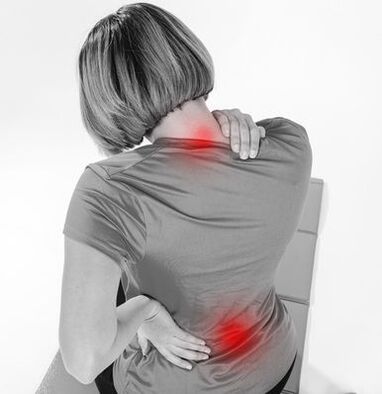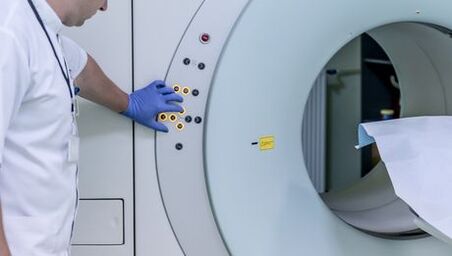
Do you feel the pain in the back and the deafness of the limbs?These are the first signs of osteochondrosis.Inadequate mobility in lifestyle, seat work, load on the neck and the spine means that the cartilage is used and losing the moisture, causing them damaged.
With cervical osteochondrosis, degenerative changes in the intervertebral discs occur.Not only slices are exposed to damage, but also the vertebrae and joints in the cervix region.If you do not treat the disease for a long time, the general health of the patient deteriorates: constant headache, the occurrence of vertebrates, deterioration of the brain cycle, whereby the cognitive functions are reduced.
The reasons for the development of osteochondrosis
A false seating position in which the neck stretches forward leads to the development of a neck disease.In this case, excessive pressure occurs on the intervertebral discs, which leads to changes in the nucleus pulposus and to press blood vessels.This position is a person at the workplace in front of the computer.Therefore, office workers are most often exposed to the development of osteochondrosis of the cervical spine.

In addition, the causes of the development of the pathology can be:
- Improper load distribution when wearing bags;
- an overly soft sleeping place (the spine is in an unnatural form);
- genetic predisposition;
- Lack of vitamins and trace elements in nutrition;
- Endocrine system disorders;
- Craumatic of the spine and violation of the attitude during the active growth of the body;
- Injuries to cervical vertebrae;
- The presence of bad habits.
Disease stages
To determine whether your pain symptoms are signs of the development of osteochondrosis of the cervical spine and which stage of the development of the disease can only be determined by an experienced doctor after examination and palpation.Overall, the cervical osteochondrosis pursues four stages of development:
- Nucleus Pulposus - The central part of the intervertebral disc in the first stage is subjected to moderate dehydration.As a result, the supportive and shock -absorbing functions of the intermediate discs are gradually lost.In the first phase you will be in pain with sudden movements, hypothermia and for a long time in a pose.
- The second stage of development is characterized by the occurrence of stagnating phenomena and cramps, which press the capillaries and blood vessels and prevents normal blood circulation.As a result, the frame of the intervertebral disc is thinner and forms a proposal (forward or backwards).Osteophytes are formed under the influence of excess load on the cervical vertebrae.Pain sensations are located in one place, with sharp curves and inclination of the head, there may be shots of the cervical vertebrae.
- The extrusion is formed as a result of the thinning of the intervertebral discs.The edge of the pulpoose nucleus breaks the fibrous ring and goes beyond the edges of the vertebral body.The muscles and nerve endings are pressed.It feels like pain in the neck, back and limb.
- In the fourth stage of the disease, the intermediate slices are moved and formed by central and lateral hernia.In addition, scars are formed on the panes, which leads to the immobility of the affected joint.The patient experiences constant back pain that is given to other parts of the body, a constant feeling of tiredness, asymmetry of parts of the fuselage.

Symptoms of a neck osteochondrosis
The symptoms of osteochondrosis of the cervical spine manifest themselves differently depending on the development phase of the pathology.In the early stages, it can be practically without the presence of characters.Pain in the neck and back can only occur in the event of a longer stay in a pose, a sharp inclination or turning.
In the later stages of development, a crunch of the spine is heard, the pain in the back is given to other limbs, there is deafness of the body parts.With the formation of osteophytes and extrusion, there is:
- Headache in the back of the head and parietal;
- Impaired language and deafness of language;
- Acceptance of the sensitivity of the skin of the neck;
- Breathing disorders;
- Blood pressure swear;
- Heart striking;
- Noise and stagnation in the ears;
- Fainting.
The symptoms of osteochondrosis of the cervical spine in women are much more pronounced than in men.This is due to the fact that women have a predisposition to vascular diseases and a more fragile structure of the bone segments of the spine.Signs of the disease occur when the intervertebral disc changes occur.This leads to a violation of normal blood circulation and causes severe headaches, dizziness and neurosis.A worsening of the disease in women often occurs during menopause when the body is exposed to changes on a hormonal background.
The symptoms of cervical osteochondrosis in men are similar to women, erectile dysfunction can be observed separately.
The headache for cervical osteochondrosis is caused by circulatory diseases in the brain and spinal cord.When the vertebrae change, press the arteries and the oxygen content in the blood.Unfortunately, such pain cannot occur even after severe painkillers.It is therefore important to approach the solution to the problem comprehensively.Dizziness for osteochondrosis cervical can be accompanied by darkening in the eyes, the appearance of noise in the ears.This happens because Spasmed muscles lead to a reduction in oxygen access to the brain.
A lump in the throat with osteochondrosis of the cervical spine as well as burns, breathing difficulties and muscle cramps - this is a frequent event.The disease provokes the nerve fibers of the cervical spine on the head and neck.Diseases of nerve impulses cause sore throats.
Due to cramps of blood vessels and the irritation of nerve ends occur.An increased lower pressure in osteochondrosis shows that blood supply to the individual areas of the brain is disturbed, since the vertebral artery is survived by the intervertebral discs of the spine.As a result, the oxygen hunger occurs and blood pressure increases.

What is the diagnosis of osteochondrosis of cervical spinal osteochondrosis?
The diagnosis of pathology begins with specialist advice.In the first manifestations of osteochondrosis, contact the rheumatologist, neuropathologist, surgeon or traumatologist orthodist.The doctor will ask about the symptoms and frequency of his manifestation.It is necessary to provide the specialist the full medical history of the disease and the results of previous studies (if available).The specialist conducts visual inspection and palpation and leads them for tests.During the examination, the doctor pays special attention to the mobility of the neck, muscle tone, the skin sensitivity and shows the most painful areas.
In order to prove the condition of the muscles, ligaments, blood vessels to detect inflammatory processes or tumors, an informative and safe diagnostic method is prescribed - MRI of the cervical spine.The patient during the MRI osteochondrosis lies with his back on a special, retractable table.Roliks are put on the head to the patient to remove the muscle tension and the limbs are attached with belts.Any insignificant movement during the procedure can affect the quality of the result.Next, the table stops in the tomograph.The procedure does not cause pain.The tomography makes a severe sound during the scan so that you can use the headphones so that you do not feel uncomfortable.
If the MRI is contraindicated, there are other diagnostic methods such as computer tomography and radiography.X -Ray is only suitable for the primary diagnosis and does not result in a layer -in -Schayer image of those affected.However, this study is the simplest and most economical with which you can examine the patient's body in several projections.Due to the strong radiation exposure to the body, radiography cannot be carried out often.
During computer tomography, scanning is carried out with one or more bundles ionizing rays.They walk through the human body and are recorded by detectors.Detectors move in opposite directions along the patient's body and fix to 6 million signals.In the picture, different tissue density with a precise determination of the limits of organs and affected areas are displayed in the form of a section.With the procedure you can get a layered image.

Treatment of osteochondrosis of the cervical spine
Only a doctor determines how to treat cervical osteochondrosis after the examination, examines the medical history and the achievement of the results of hardware diagnostics.If the disease was diagnosed at an early stage, the treatment will experience conservative options.When treating osteochondrosis, it is important to adhere to an integrated approach - to take medication, to operate physiotherapy, to operate a therapeutic massage and to avoid strong physical exertion.
First you have to stop the pain.For this purpose, analgesics and pain relievers are prescribed by local actions.She is prescribed with strong muscle cramps to carry an orthopedic collar.After the pain syndrome has been removed, it is necessary to stop the inflammatory process and restore the normal bloodstream.For this purpose, antioxidant, anti -inflammatory therapy is carried out.Therapeutic exercises are prescribed as additional measures.You can participate in physical education at home and with a trainer.
If osteochondrosis has become serious, the doctor can prescribe surgical intervention.The operation falls back on rare cases in which the pathology develops against the background of other diseases - scoliosis, hernias of the intermediate brales, curvature or shift in the spine.
The treatment of cervical osteochondrosis in women does not differ particularly from the treatment of men.However, doctors often recommend heating external compresses and strengthening the muscles of the neck.
Experts recommend from early childhood to prevent different back diseases.To do this, you have to form the right posture when walking and staying on the desktop.The full nutrition and the proper strengthening of the muscles of the back will help to avoid negative consequences in the future.





































